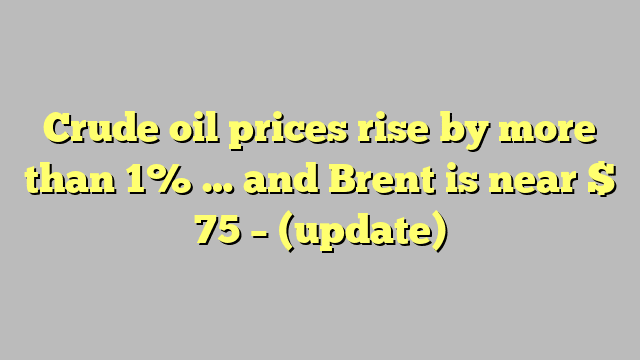Crude oil prices rose by more than 1%, at the end of today’s trading, Thursday, March 16 (2023), after 3 sessions of losses, as a result of which they fell to their lowest levels in 15 months.
Oil markets calmed somewhat after Swiss regulators threw away a financial lifeline to Credit Suisse, but fears of a worsening banking crisis around the world still clouded sentiment.
Sources in OPEC + had confirmed, in exclusive statements to the specialized energy platform, that the decline in crude oil prices is a “natural reaction” to what is happening in the market, indicating that the alliance does not intend to make any change in production policy during the current period.
Crude oil prices today
At the end of the session, the prices of benchmark Brent crude futures – for May 2023 delivery – rose by about 1.4%, to reach $74.70 a barrel.
The price of US West Texas crude futures – delivery in April 2023 – increased by 1.1%, to $68.35 a barrel, according to data seen by the specialized energy platform.
And crude oil prices ended their dealings, yesterday, Wednesday, March 15, with a decline of more than 5%, driven by fears of economic recession, following the collapse of the US Silicon Valley Bank.
Oil market conditions
A new report issued by the Swiss investment bank “UBS” revealed that the financial market turmoil and the US banking crisis affected crude oil prices; The benchmark Brent crude price has fallen by more than $10 a barrel over the past 10 days.
And crude oil prices recorded, during yesterday, Wednesday, the third day of declines in a row; US crude fell below $70 a barrel for the first time since December 20, 2021.

Brent has lost nearly 10% since Friday’s close, while US crude has fallen about 11%, according to data seen by the specialized energy platform.
The UBS report – a copy of which was obtained by the energy platform – ruled out that the crisis would put pressure on the demand for crude oil and its production.
The report indicated that crude oil prices were affected by the recent changes in risk trends, especially due to the lack of fundamentals supporting prices, with the rise in US oil stocks during the current year (2023).
Commodities analyst at Swiss bank UBS, co-author of the report, Giovanni Stanovo, said that the markets are likely to remain volatile in the near term, and we still expect that higher Chinese imports of crude oil, demand, and lower Russian production will push prices towards increase in the coming quarters.
Oil price forecast
“Given that this is really everything driven and not driven by oil fundamentals, WTI could flirt with the idea of hitting as low as $60, but I don’t really see a breakdown,” said Victor Katona, senior crude oil analyst at data analytics firm Kepler. complete”.
Credit Suisse said on Thursday it would borrow up to $54 billion from the Swiss central bank to boost liquidity and investor confidence, after a decline in its shares heightened concerns about a global financial crisis.
For his part, analysts from Haitong Futures said: “Market sentiment deteriorated with the expansion of the banking crisis to Europe from the United States .. the future direction will depend on the level of concern of the market even if the fundamentals do not necessarily show much in the way of bearish signs,” according to Reuters.
demand for oil
Analyst at Philip Nova PTE Lim Tai An said that OPEC’s more optimistic outlook on China’s oil demand supported crude oil prices.
OPEC raised its forecast for Chinese demand for 2023 earlier this week, and the International Energy Agency report, yesterday, Wednesday, indicated an expected increase in oil demand from the resumption of air travel and the reopening of the Chinese economy after abandoning the policy not to spread the Corona virus.
The International Energy Agency said, in the report, that commercial oil stocks in OECD countries reached their highest levels in 18 months, while Russian oil production remained near pre-war levels in February despite sanctions imposed on its seaborne exports.
The Energy Information Administration said on Wednesday that US crude oil inventories also rose last week by 1.6 million barrels, exceeding analysts’ expectations for an increase of 1.2 million barrels.
Later on Thursday, ECB policymakers are expected to lean towards a half percentage point hike; The Eurozone economy is regaining strength and inflation is expected to remain high for years.
Higher interest rates could lead to lower demand for oil as economic growth slows, but concerns about a widening financial crisis for the banking sector could also affect demand for oil.
related topics..
Also read..

Leave a Reply